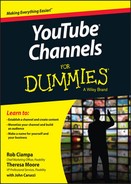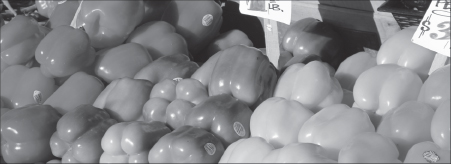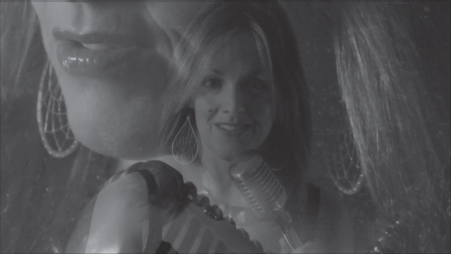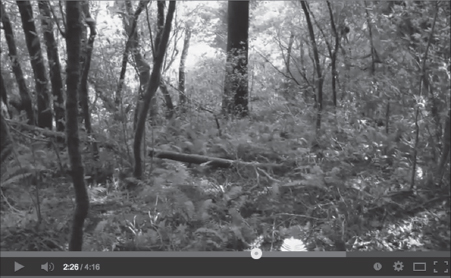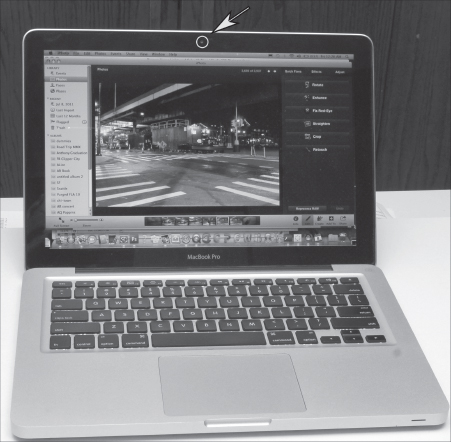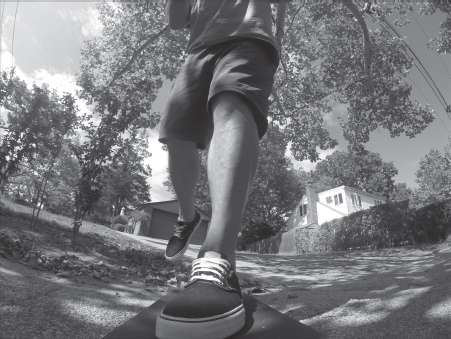Chapter 4
What Makes a Good Video a Good Video?
In This Chapter
- Choosing the right camera
- Understanding the basics of making a good video
- Mastering different video genres
- Dissecting the video
Not that long ago, video was a far cruder, much simpler medium. At home, people had more fingers than television channels, and for those making their own movies, consumer-level video came in two varieties: bad and worse. Maybe that's a bit unfair, but the quality lagged far behind commercial productions.
Clunky cameras that captured low-resolution video were no match for the broadcast-quality content found on television. And the quality of television was inferior to the look of a feature film. Not sure about that last one? Just watch a music video from the early days of MTV, circa 1982.
Since that time, technology has evolved to the point where you can now watch hundreds of channels and where most anyone who wants to has the ability to make a broadcast-quality movie that can be seen by potentially a global audience. Consumer-level camcorders not only come close to broadcast quality but can also even rival it. That means your YouTube video can look truly professional. Of course, can is the operative word here.
Clearly, technological advancements have allowed online video to change the rules of consumer-level moviemaking. Yet, because of the relative adolescence of online video, there's some confusion about what makes a good video. Understandably, that criterion depends on the particular genre of video. For example, a music video has a different set of standards than an instructional video on techniques for giving your date a goodnight kiss. And that differs significantly from the standards you'd apply to a video showing your cat chasing a red dot. Though diverse in content, there are still some fundamentals that every video should adhere to.
But what fundamentals are we talking about here? What makes a good video, in other words? Given the nature of human taste, coming up with clear criteria for defining a good video may be a fool's errand, so it might be better to concentrate on avoiding those factors that make a video nearly unwatchable. As a video producer, that makes your job relatively easy. Just eliminate the negatives — such as shaky camera work, distorted audio, or bad exposure — while providing entertaining content.
It sounds easy, but you're right to suspect that it may be a little more complex than that, due in part to some false conceptions that folks still hold about online video. Some people still believe that an online video, or one destined for YouTube in this case, doesn't require the same quality as any other production destined for broadcast. That's simply no longer true. The way things have shaken out, more and more viewers are watching content online rather than on broadcast TV, and they are demanding better and better quality. This demand means that, with more people watching video on sharing sites like YouTube, the bar continues to rise when it comes to production value and content.
We talk a bit more about fundamentals later in this chapter, but right now we want to take a look at the most fundamental fundamental out there — your choice for capturing video.
Picking the Right Camera for Your Needs
Once upon a time, a video camera was that bulky device you bought to capture moving images on video tape. Over the years, the cameras got smaller and tape formats evolved from analog to DV and from HD to 4K, with corresponding increases in the ease-of-use and quality categories. Not only that, but the prices dropped precipitously, which means that you can now buy a decent camera at an affordable price.
The only difference now is that there's a wider — some might even say “bewilderingly wide” — selection of cameras. The following list describes the major categories:
- Dedicated camcorder: Once it was the only way to capture video, but now the trusty dedicated camcorder has been relegated to simply being one option among many. Benefits include a time-honored design for comfortable shooting, dedicated features and controls specific to moviemaking, and a wide zoom range on a single built-in lens, as shown on the Panasonic HD camcorder in Figure 4-1. It's also designed to accept a variety of accessories — an on-camera light, say, or an external microphone or a handheld rig. On the downside, camcorders lack the ability to capture a wide-angle view. Most can cover a long telephoto range but can barely fit all the subjects in a room into the frame. Another dilemma is its monomaniacal devotion to a single task — making movies. That means some users may pass on a camcorder simply because they can't use it to send a text or make a call.
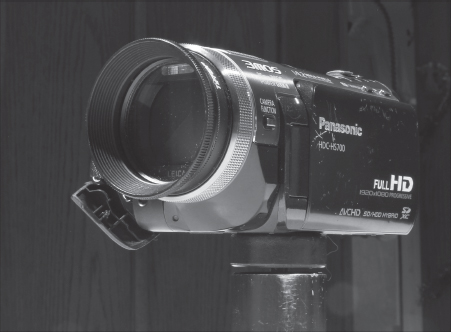
Figure 4-1: This Panasonic HD camcorder is far more compact than its predecessors, yet bigger than most cameras that capture video these days.
- Digital SLR: The digital single-lens reflex camera (or digital SLR, for short) rightly dominates the still-photography market, but it turns out that many models provide the ability to capture pretty good HD video. That's a great thing because the image sensor (when compared to conventional camcorders) is significantly larger, and therefore captures better quality. The camera can take advantage of all lenses that fit its mount, so you can capture movies using a wide range of lenses, from extreme telephoto to ultrawide-angle. In addition, you can make a movie out of still frames and add an audio track and maybe some music. Many accessories are available, from mounting rigs to external microphones to LED lighting. On the downside, the camera controls and the way the camera fits in the hand favor still photography over moviemaking, and the accessories can be expensive.
- GoPro: This mini marvel is rugged, waterproof, and relatively inexpensive, and it's mountable on just about anything to capture amazing quality, from a unique perspective on a skydiving helmet to the rider's view on a BMX bike, as shown in Figure 4-2. Some models can even capture 4K video, the new standard for ultra-high-definition television. On the downside, the GoPro is limited to capturing an ultrawide-angle view.

Figure 4-2: Mounted directly on the bike with a handlebar mount, the GoPro provides a view that wasn't possible just a few years ago.
- Smartphone: Just a few short years ago, considering a cellphone as a means of capturing a serious video would earn you an eye roll because the results were often dismal. Not anymore, because serious works have been captured on a phone, including the Oscar-winning documentary Waiting for Sugarman. On the downside, you have little control in adjusting the audio or video quality. You also have limited choices for accessories.
- Webcam: A webcam is inexpensive to purchase, on the off chance that you don't already have one built into your computer. That makes it perfect for situations where you sit down in front of the computer. Just plop yourself down, check the lighting, and start talking. Since most can now capture in HD, you're good to go. The downside is that you need to stay put or else you might position yourself out of the frame. The audio can sound “thin” if you're not using an external microphone. And worse than that, if the lighting is too harsh, you can look really bad.
 Purchasing a top-quality model and instantly expecting to make great movies isn't much different from thinking you can purchase a Gibson Les Paul and become a great guitarist without knowing how to strum a single chord.
Purchasing a top-quality model and instantly expecting to make great movies isn't much different from thinking you can purchase a Gibson Les Paul and become a great guitarist without knowing how to strum a single chord.
Both guitar playing and videography depend on understanding technique. Gone are the days of haphazardly handholding the camera while randomly shooting a movie on the fly. It will not only lack cohesion but can also make the audience feel like they're having a seizure. As much as we like talking, thinking, and writing about cool cameras, we want to stress the fact that technique is crucial. That's why we focus much more on technique in this chapter than on fancy hardware.
Knowing What Makes a Good Video
An immediate side effect of watching bad video is that you no longer want to watch it. But that still begs the question of what makes a YouTube video truly good. Sometimes, that answer is a little harder to figure out. The more obvious indicators of a good YouTube video are that it's informative, depicts compelling situations, and, of course, makes people laugh. All these factors certainly contribute to the success of a YouTube video, but you have more pertinent issues to consider that deal with the technical aspects of making these videos enjoyable.
Keeping the camera steady provides a good start, as does making sure the lighting effectively represents the scene and that the audio is clear and pristine for the viewer to understand. It's also important to have a mix of shot types to keep things visually interesting — in an interview, for example, cut between the subject and a scene of what the subject is discussing. Though these attributes are somewhat “below the radar” when people are enjoying the video, they lie nonetheless at the core of an enjoyable experience.
Here are a few of the components that make a good video:
- Good lighting: “Let there be light” remains one of the oldest phrases ever. And for good reason. Without light of any kind, people clearly wouldn't be able to see anything — though good video depends on more than just seeing the subject. Good lighting — as opposed to merely adequate lighting — needs to bathe the subject in a flattering way, as shown in Figure 4-3. It doesn't matter if you're using a sophisticated light kit or ambient illumination or depending on the sun, as long as the final product looks good.
- Top-quality audio: The better a video sounds, the better it looks. Less-than-stellar visual elements can easily be accepted when the sound is clear. But the opposite statement rarely applies.
Figure 4-3: The peppers come to life as the sun bathes this outdoor market in late afternoon light.
- Steady camera: Using a tripod (shown in Figure 4-4) or another means of stabilization clearly makes it easier to maintain a steady shot, but if you're stuck without a tripod, at least try to keep your handheld camera as steady as possible so that you can avoid that annoying herky-jerky motion.
- Shot structure: If you're editing video, you should strive for a nice selection of shot types and angles in order to keep your viewers engaged. Think about it: Nobody wants to see the same exact shot and angle for 10 minutes.
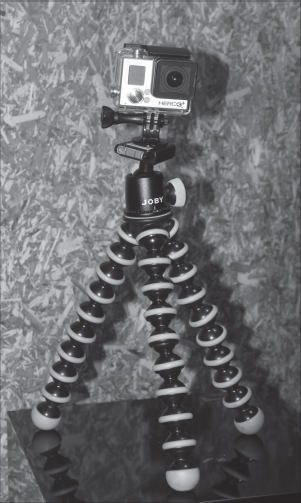
Figure 4-4: Neither tripods nor cameras need to be big now, as proven with this GoPro mounted on a Gorillapod.
Mastering the Genres in Your YouTube Videos
YouTube videos cover a wide range of subject matter that appeals to a wide range of viewers. Though each requires its own, special finesse to make it effective, all share the same need for quality.
The following few sections take a look at the different types of video and the special needs for each type.
Mastering music videos
Music as a subject pervades the YouTube landscape in many forms. These include everything from the official video for the song from a recording artist to live concert performances to high school musicals and musicians seeking viral exposure. When it comes to musicians creating that “breakout” video, consider the South Korean pop star Psy. He became an international sensation with his “Gangnam Style” video. To date, that song has been viewed more than 2 billion times and counting. Of course, music videos, official or otherwise, represent a large share of YouTube's content, so you'll have to be creative to stand out.
 With any type of music comes copyright concerns, either about the song or the band performing it. See Chapter 16 for more details on copyright.
With any type of music comes copyright concerns, either about the song or the band performing it. See Chapter 16 for more details on copyright.
So when it comes to making your music-based video, here are a couple of suggestions to consider:
- Get the audio right. If the music doesn't sound good, the picture won't look good. That statement applies to just about any video, but when the subject is music, it takes on an even greater purpose.
- Keep it visually interesting. Conventional wisdom suggests that some situations require compelling visuals, like in an MTV-style music video, whereas in other situations, the performances are more straightforward and may work well with merely a limited number of camera angles. Just be sure that the visuals work with the music — just because you've got a great tune doesn't mean that you should skimp on the camera work. Remember that it's an audiovisual experience, so take advantage of it, as shown in Figure 4-5.
Figure 4-5: Still frame from the “Beautiful Eyes” video, by Alice Ripley (video produced by John Carucci).
If you're making a music video, here are a few tips to follow:
- Listen to the song. And do it over and over. That's the only way you can get a true feel for the most effective way to visually depict it.
- Create a concept. After listening to the song, you should have a better sense of writing an effective script. Just don't let your vision exceed your capabilities. You can run out of time, exhaust your budget, or maybe embark on something you're not ready to accomplish.
- Find your locations. You have to shoot your video someplace, so why not find the best place possible? Uncovering the best spots to shoot the video, obtaining the necessary permissions, and observing the light and flow are all tasks you'll want to do well in advance. For the music video shown in Figure 4-6, the area was scouted for proper lighting and setting.
- Communicate with the artist. A music video is a collaboration between the artist and you. That's why it's a good idea to make sure everyone is on the same page regarding concept and ideas. If a disagreement crops up during production, you could find yourself majorly frustrated.
Producing your very own vlog
Ever hear of a portmanteau word? It's when two different words are combined to form a new one that best describes the situation. Think about Brangelina, the couple known separately as Brad Pitt and Angelina Jolie, or staycation, the stay-at-home vacation, though it's generally more home than vacation. In the video world, the portmanteau word of choice is vlog, the strange blend of consonants that brings together the words video and blog.
Figure 4-6: Still frame from a shoot in California's Muir Woods.
Before the turn of the millennium, one might take the odd word vlog to mean something completely different. But these days everyone knows about the vlog. The vlog has in fact become a staple on YouTube. Some vlogs are quite funny, and others truly informative, yet way too many are simply not worth watching.
That's because vlogs are either poorly produced, or they lack focus in their subject matter, or they suffer from a combination of both. Like most other staples, the bar has been raised on what's now acceptable.
Here are some suggestions to maximize your potential when it comes to your vlog:
- Use a good-quality camera. Though a DSLR produces the best quality, a webcam — as long as it can capture HD — works pretty well, as shown in Figure 4-7. Plus, it's simple to use and requires little, if any, setup.
- Use a separate microphone. It may not always be easy to work with a microphone, but trust us — it's often worth the aggravation. Why have your voice sound tinny and distorted when all it takes is plugging in an external microphone? Even a cheap one will make your voice sound better than the microphone on the webcam or your computer. You can even use a lavalier, as shown in Figure 4-8.
- Be consistent. If you're looking for an audience, think of yourself as a brand. That means the format and setting should remain consistent with each video. Here's an opportunity to show some originality with props, background, and set.
- Improve the lighting. If you think the overhead lamp and illumination from your monitor will suffice, think again. We strongly recommend adding some light outside of the video frame. If you don't want to use photo lighting, a plain household lamp (with shade) that's capable of providing bright, soft illumination is your best bet.
Figure 4-7: Built-in webcam on a MacBook makes it easy to shoot the next installment of your vlog.

Figure 4-8: A lavalier clipped to a lapel can greatly improve audio quality.
- Don't ramble. The difference between a great blog and a terrible blog depends on several factors — the host's sense of presence, the subject matter, and the length, for example — but it's the host not getting to the point that often acts as the deciding factor for the viewer to move on to another video. Don't be that person. Instead, plan in advance what you want to say, and when the time comes to record it, be sure to manage your delivery effectively. Also, be sure to capture several takes so that you end up sounding as fluid as possible.
- Don't count on needing only a single take. It's not a sport, nor is it something you need to do live, so always take your time and reshoot parts that are not perfect — not just for getting your vocal delivery right, but also to make the video visually more interesting. You can do that by shooting each take from a different angle or by framing your subject a bit differently.
Making an educational video
YouTube has become a great place for people of all ages, education levels, and interests to learn. And why not? It's a central location where viewers can find out about just about any topic; besides, though it's one thing to read about a subject, watching it on video provides a whole new perspective. You'll find history lessons, teaching aids, and coverage of current events all on YouTube.
Here are some tips for producing an educational video:
- Know your audience. Before Goldilocks tells you that one video was too hard to understand and that another had information she already knew, it's up to you to make it just right. That starts with knowing your audience — knowing what they're capable of and also knowing what your audience most needs to know.
- Keep it simple. There's no reason to show or tell any more information than necessary. In other words, stay on topic. Have a singular focus and be sure to use lots of strong visuals.
- Be concise in your introduction. Potential viewers must have some idea of what they can learn. That's why it's important to have a clear description of the video. If you can't explain it in two lines, you should consider reworking your idea.
- Write a good script. At its core, the educational video is still a movie. And like a great movie, its success begins with having a good script that both entertains and gets to the point. Make sure to write the narration as succinctly as possible and make the visuals consistent with your time constraints and budget.
Making tutorial and how-to videos
Search on YouTube and you'll find endless videos that explain how to do everything from kissing a girl after the prom and drawing a freehand circle to replacing an iPhone screen and making an epic movie trailer. YouTube even has videos on how to make a how-to video. Some of these how-to videos provide lessons that are quite informative; some are also quite entertaining, whereas others simply serve as examples of how not to make one.
If your goal is to make a good vide rather than the typical not-so-good one that's too often found on YouTube, you'll need to heed the following advice:
- Know the subject. It sounds obvious, but some of those less effective how-to videos suffer from a lack of understanding of the topic from the production side. Stick to what you know best and take it from there.
- Prepare a script. A good script acts like a roadmap for making the movie, no matter what the subject matter. So, tutorials are no exception. Though everyone has their own method of tackling a topic, one idea is to create a skeleton of the entire process by writing down every step. After that, you can rewrite it as a script, taking into account video content and (of course) witty puns.
- Use title cards. Title cards are not only cool in an “old school” kind of way, they can also help viewers understand the topic. Using words in your video helps the lesson sink in. You can use title cards to introduce each step, and to provide a summary.
- Shoot cutaways. A cutaway is one of the most effective components in a movie. It's basically a break in the current video by the insertion of another shot, one that's often related to the action at hand. Close-up and detail shots provide a clearer picture (pun intended) of the use of cutaways, but don't do them while shooting the actual video lesson. Instead, shoot them afterward, or before if that's the way you roll. Why? So that you have clean shots to edit later. It's often jarring for the camera to zoom in during the lesson.
- Shoot multiple takes. Editing is your friend, so shoot several versions of the same scene to try out different approaches or simply to get it just right. These alternative shots give you enough content to work with while editing.
- Make sure the narration is clean. Clean means clear and concise speaking, simple phrases, and no jargon. And one more thing: Read the text many times to get as comfortable with it as possible.
Let's play (and make) gaming videos
Whether you're explaining how to find a settlement on Durotar in World of Warcraft, battling the Archadian Empire in Final Fantasy, or simply providing some tips in Clash of Clans, chances are good that lots of people are looking for these kinds of tips and more on YouTube. So if video games are your thing, and you want to share your exploits and advice with others or perhaps teach them something, why not make your own gaming video?
What's a gaming video without a real example from the game? Boring. So you want to be able to capture the action using a screen capture program. The simplest way is to have your game loaded on a computer rather than on a gaming system.
Here are a few choices that are inexpensive and work pretty well:
- Snapz Pro X: Allows you to capture still images, audio, and video using a few keystrokes on your Macintosh computer. You can download it at www.ambrosiasw.com/utilities/snapzprox.
- Debut Video Capture: Works on both Mac and Windows computers and lets you record video (including streaming video) on your computer screen, as shown in Figure 4-9. You can download it at www.nchsoftware.com/capture.
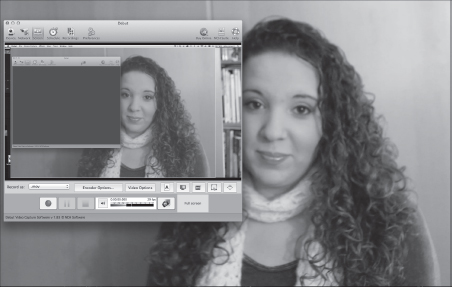
Figure 4-9: Debut Video Capture.
Making animal videos
Take an informal survey and you'll discover an insatiable fondness for videos that feature animals. People love to watch them over and over as well as share and share. That probably explains why the most viral content is content that features our four-legged friends. The recent Mutant Giant Spider Dog video has already attracted more than 125 million views. And spider dog is not alone. Numerous videos are dedicated to the feline accomplishments, too, like cats answering with meows, fraternizing with dogs, or just being cute.
But the animal video is not dominated entirely by dogs and cats. In fact, you'll encounter every animal imaginable on YouTube. Horses, cows, monkeys, and even lions and tigers and bears are represented on YouTube.
So if you think your pet has what it takes to be a YouTube sensation, it's time to break out the ol' camcorder and make Fido a star.
Follow these tips for making animal videos on YouTube:
- Keep it short. Many of the most-watched videos on YouTube are often less than a minute long. That, apparently, is all it takes for a major dose of cute. And shorter videos attract more clicks.
- Find a willing participant. Some dogs — and other animals, for that matter — are more inclined than others to ham it up for the camera, as shown in Figure 4-10. If you have one with the acting bug, consider taking out your camera because — who knows? You may have a potential star on your hands.
- Nail down the right location. That's what they say it all comes down to — why else would they repeat it three times? We're not sure whether that makes the saying triple-ly true, but it does add value to the video when you find the right place. If it's a house pet, that can mean a tidy space in a part of your place that has sufficient lighting and is free of clutter. For outdoor situations, choose an area free of clutter, and make sure the sun is at your back.
- Reward the participants. Dogs and cats work for treats, so when they do a good job, it's important to compensate them.
Capturing sporting events
With the exception of professional sports leagues with a YouTube channel or a news organization granted rebroadcast consent by a professional league, most sports videos found on YouTube consist of extreme events and amateur sports. Because the latter often borders on boring for all but those connected to it (family members, participants, sadists), the former provides the best opportunity for the ambitious videographer.
These days, capturing extreme sporting events and activities has gotten easier, thanks to the GoPro. This durable little camera helps provide a fresh perspective by putting the viewer directly in the middle of the action, making GoPro videos some of the most compelling videos on YouTube. Besides, the GoPro is waterproof, captures amazing quality, and can mount to just about anything. (For a deeper dive into GoPro cameras, be sure to check out GoPro Cameras For Dummies, written by John Carucci and published by John Wiley & Sons, Inc.)
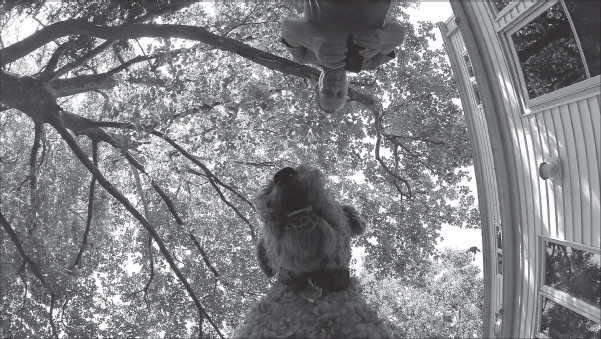
Figure 4-10: Windee the Airedale gets ready to shoot a scene.
Here are some (extreme) ideas:
- Skateboarding: Since it's a popular sport among young people, chances are good that there's a good audience for your skateboarding video, as long as it's compelling to watch. You can shoot with anything from a dedicated camcorder to your iPhone, or mount a GoPro to the board itself, as shown in Figure 4-11.
- Skydiving: Here's another situation that was changed by the GoPro camera. Just mount the camera to your helmet and capture a perspective that has rarely been seen until now.
- Skiing: Wow, it seems like a lot of extreme sports begin with the letters sk, and although skiing is more common, it can be every bit as extreme, especially when a parachute's involved and you're skiing off a cliff. You can provide your audience with the skier's perspective by mounting your GoPro in a variety of places, including your helmet, on a chest harness, or directly on your ski pole.
- Water sports: Attaching a waterproof video camera to your surfboard or raft or on your person while waterskiing can result in some compelling video content of places that a camera dared to tread — assuming, of course, that you don't wipe out after the first three seconds.
Figure 4-11: You can easily attach a GoPro to a skateboard to get a board's-eye view of the scene.
- BMX: The possibilities are endless because you can mount cameras anywhere from the bike itself to your helmet to strategically placing cameras on the course and from the crowd.
Film and animation
YouTube has liberated the stage or, more appropriately, the screen for filmmakers of all levels by allowing them to reach a global audience. Not that long ago, you would make a short film and then physically show it to your friends and colleagues in a dank screening room, a classroom, or (more than likely) your own basement.
On a good day, the screening may have seen scores of people. That would mean you would need dozens of showings, if not hundreds, to duplicate the reach of your YouTube channel moments after you upload a movie. Besides exposure to a large audience, you can also enter your film in various online film competitions.
Here are a few types of movies you can find on YouTube:
- Film shorts: One traditional gateway to directing a feature film comes from making a film short. But how a person actually ended up seeing one of these films remained one of the great mysteries in filmmaking. We all hear whenever they're nominated for an Oscar, but never knew where you could see one. Nowadays you can view short films of all genres on YouTube, and maybe even see a future Oscar nominee.
- Web series: These (mostly) scripted series are the YouTube version of a television show. And just like their broadcast cousins, they cover a wide range of topics, situations, and subject matter. Instead of the standard 30- or 60-minute episode blocks, however, the web series is broken down into installments that range from five to ten minutes each. Popular web series include Between Two Ferns with Zack Galifianakis, the hipster comedy adventure, High Maintenance, and the award-winning series The Guild.
- Animated movies: If you're a fan of animé or you want a place to show it off, YouTube can help you reach your audience. Whether you're going old school with cell animation, doing stop-motion with objects, or venturing into computer-generated imagery, YouTube provides a great place to share your work with the world. You can even create an animated web series.
Entertainment
Most videos should entertain the viewer in some way, and that includes the ones that are about entertainment. Content that covers celebrities, movies, music, theater, and television should entertain the viewer beyond its subject matter. So although all video should be entertaining, videos on areas associated with the entertainment industry should be doubly entertaining.
Though entertainment covers a wide ranges of topics, here are some of the areas you're likely to see:
- Celebrity interviews: These can cover a wide range of subjects, including comments on specific projects, opinions on current events, and humor interest.
- Red carpet coverage: Stars attending their movie premieres, arriving at award ceremonies, or supporting their favorite charities are popular subject matter, as shown in Figure 4-12. Many make comments to the press, and some show off their fashion sense.
- Entertainment news: This one covers the news side of the industry, with coverage of areas like obituaries, divorces, babies, and impaired driving arrests.
News and information
YouTube offers far more content for viewers than perusing the latest music videos, marveling at people doing truly weird stuff, or looking at dogs dressed in costumes. Though these provide a pleasant escape, you can also use YouTube to stay informed when it comes to news and current events. It's not live news, but that doesn't really take the news out of it. Instead, it consists of replays of newscasts, editorials on every imaginable topic, and news segments and packages that cover anything from business and national news to entertainment and health issues. That's why almost every major news outlet has a YouTube channel where you can look at clips and watch video segments.
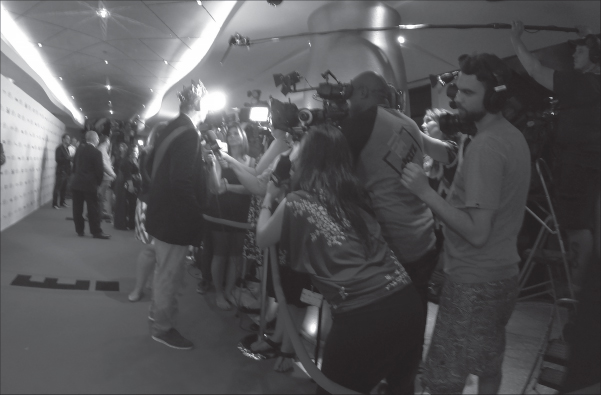
Figure 4-12: Red carpet action, captured at the Toronto International Film Festival.
Here's a brief list of news organizations represented on YouTube:
- Associated Press Television
- ABC News
- NBC News
- BBC News
Viral Videos versus Evergreen Content
One phenomenon created by the Internet is the spread of viral video. Just like a virus (except that it's the good kind that won't make you sick), a viral video spreads rapidly online and can garner a million views in a relatively short time.
On the opposite side of the spectrum lies the evergreen video: As its name implies, videos with this distinction usually remain fresh and vibrant for longer periods, providing a timeless quality to the content.
Your channel's objective depends on being able to bring as many viewers as possible to your content. Sometimes that comes from a single, albeit extremely popular video, whereas at other times it's more about having a healthy lineup of relevant content.
Creating a single viral video can bring a great deal of attention to your channel, and those visits can quickly monetize into big bucks, especially with a video that garners a couple of million views. On the other hand, evergreen videos (see below) lend themselves to less dynamic, though more steady buildup through a variety of content that keeps people coming back.
 Don't bet your YouTube strategy trying to create a viral video. When it comes to viral videos, there's a random element to their success that cannot always be duplicated the next time around. Nevertheless, you can do some things to make success just a tad less random — we tell you more on that topic in the nearby sidebar “What makes a video go viral?”
Don't bet your YouTube strategy trying to create a viral video. When it comes to viral videos, there's a random element to their success that cannot always be duplicated the next time around. Nevertheless, you can do some things to make success just a tad less random — we tell you more on that topic in the nearby sidebar “What makes a video go viral?”
Viral content
Viral videos usually consist of some trendy or contemporary aspect that allows it to build a huge audience quite quickly. For example, a new dance craze or music video sometimes makes for the most watched video, but it can also consist of a dramatic news event or wild stunt that people can't stop talking about. Sometimes it fades away as quickly as it started, whereas at other times it sticks around.
Evergreen content
Like a tree of shrubbery that never turns brown, the evergreen video remains popular with its niche audience for a long time. That's because it consists of content that people are going to search for often and over an extended period. If YouTube were a refrigerator, comparing the two, a viral video would have a shorter expiration date to more evergreen content. Though there's less pressure to creating a successful evergreen video, it still requires a lot of work to gain a following. You have to let people know that it's out there while keeping it relevant for them to venture out and find you.
The types of content that may have (potential) evergreen value include
- Instructional videos
- Educational videos
- Travel videos
- Overviews of holiday traditions
- Biographies of famous people
Most evergreen content — instructional videos or content associated with a historical event, for example — doesn't usually go viral but can enjoy a longer run of popularity because the content will continue to attract a steady stream of viewers.
What makes a video go viral?
Viral videos usually have a humorous or quirky feel to them, and though most of the time they unintentionally gather a mass following, some corporations have managed to produce successful viral videos quite intentionally. But there's no guarantee that your video will find success, even if it's a promotional video with big money behind it.
Like the countless grains of sand, millions of videos are uploaded to YouTube — but only a few become viral sensations. As with winning the lottery, the success of a viral video is more “hoped for” than “planned for.” Still, you can improve your chances by considering some attributes that other viral videos have displayed.
Consider these suggestions:
- Engage the viewer. You have to grab their attention before they know what hit them.
- Be relevant. Trends and pop culture references have a wide appeal to audiences, so why not integrate them into your video?
- Add humor. Make 'em laugh and they'll keep coming.
- Be brief. After grabbing viewers' attention and holding their interest, don't take a chance on losing by going on too long or having a lull in the action.
- Use popular subjects. The biggest YouTube video of 2014 showed a dog dressed as a giant spider. So consider animals as one popular subject.
After completing and uploading your video, here are some aspects that will help it along its viral path:
- Spread the news over social media. Tweet out your video link, post it on Facebook, and ask friends to share it.
- Send out emails. Send out an email blast with the YouTube link.
- Blog about it. If you have a blog, then blog about your video. Also reach out to other bloggers and ask them to do the same.
- Listen to feedback. It's no secret that comments found on YouTube can be hurtful, but some are actually helpful. Try to sift through them to find what people like about your video.
